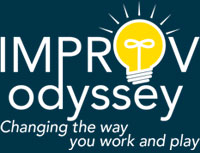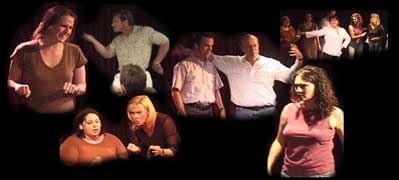Teacher, Coach Thyself
Sidecoaching is essential to a game and helps the player breakthrough his or her resistance(s) whatever they may be, and soar into that unknown area, their own treasure house of creativity and intuition where growth and transformation occurs.
Sidecoaching is an art in itself and a necessary component of Spolin Games that gets to the heart of improvisation in the larger sense – transformation. Viola Spolin does not spend enough time in Improvisation for the Theater to deal adequately with the problems of being an accomplished sidecoach. For me that is a big problem.
Sidecoaching is an essential and important way to play with your fellow players as player/coach. But developing one’s mastery of it needs addressing.
I was lucky enough to be coached and mentored by Viola Spolin herself and still my education took years before she was comfortable with me coaching and gave me her blessing. I would like to address the problem of becoming a skilled sidecoach. I acquired my skill, with once-a-week training and weekly meetings with the high priestess of Improvisation over eight years and continued to refine it through my friendship with Ms. Spolin for the remainder of her life. I continue to examine and try to refine my skill as a sidecoach. It is an always shall be an ongoing process.
There is a drawback for those who use Viola Spolin’s written work solely to teach Improvisational acting or Improv Comedy: They don’t know how to effectively sidecoach. The book Improvisation for the Theater discusses sidecoaching and outlines the process, as does the Handbook from The Theater Game File, but becoming a good sidecoach is a skill that needs constant practice and careful monitoring. It is trial and error as is playing the games and that is as it should be, but I would like to find a way to stress its value and accelerate the process for teachers.
So many teachers/directors, get Spolin’s book, peruse it and dive right into coaching games they’ve never played or maybe even seen. This is why Improvisation as conceived by Spolin winds up being misunderstood, and misused by so many. Especially those ignorant of the ultimate aim of the games – Stepping into the unknown with joy, anticipation and confidence and skill. In the hands of the uninitiated, Spolin’s games are often used improperly. To some Improv teachers who use other systems, they seem basic and in some cases irrelevant to the goal of producing an end result; comic improv scenes (short form), full length Harolds, Armandos, etc. (so-called longform) and rehearsed sketches developed from Improv.
I remember an incident where I was auditioning players to join a new ensemble and set up auditions at a local rehearsal hall. I explained the game to be played, cast some people in it with a Who, What and Where and gave them a focus like Gibberish, or Contact or something to work with. I explained that I will be helping them to play fully by sidecoaching them.
In one particular scene, a woman simply sat in a chair and verbally described her relationship, told her feelings and described rather than showed where she was. She was being very dramatic. I called out a few coaches to help her. “Use your where!” No response. She continued to verbally describe who she was, her relationship and why she was there. “See where you are! Show, don’t tell!” I urged her. It made her nervous and she began to get urgent, shutting out anything her fellow player was offering. “Sloooowwww Motion!” I yelled.
She stopped the scene and walked to the edge of the stage where I was sitting and said “Will you please shut up! I am trying to Improvise here!”
“I’m trying to help you improvise.” I said.
“You’re making me feel like a total failure! Don’t say anything while I’m playing please. Give me your notes afterwards like a regular director.”
She entirely missed the point and there was little I could do. She wouldn’t allow herself to be sidecoached. She, I might add, told me she was an accomplished improviser for many years in many troupes and had never encountered sidecoaching. “It’s intrusive.” She told me.
Some teachers and directors (maybe many) don’t use Viola’s suggested sidecoaching phrases at all. Much Improv training has gone that way. I think it is because they don’t see how to apply it effectively. Or, if they do use it, it’s just as likely they may use it where it doesn’t apply just because the phrases are written there and you think you are expected to use them so you call out phrases by rote or randomly, hoping for the best.
Sidecoaching is a delicate art/science requiring great skill. I’m sure many teachers/directors/coaches, having never experienced the games first hand – as a player, teach the games all the same, unaware of the tremendous contribution a good sidecoach can make. Many teachers rely solely on the rules and the explanation that Spolin outlines in each exercise. They try to get students or players to accomplish the focus and acquire the skill the game was designed for. At this level the games do indeed work without much coaching if properly set up.
But this is only the first layer of the onion. I do not mean to discount the Book’s value as a practical method to teach acting. Acquiring a theater skill is its primary objective. It is and on that level Improvisation for the Theater is a brilliant guide. I only want to stress that an intellectual or casual understanding of the games may not give you an intuitive understanding of what to side-coach and how to reach continually into the intuitive, x-area. The approach to the unknown.
I would like to urge you to delve into and contemplate the problems of effective sidecoaching. I want to help you reach that ultimate goal Viola was after: The heart of Improvisation – Transformation. It is acquired through personal experience. And I hope my experiences in this blog will not only shine a light on your journey, the journey every teacher/sidecoach should take, but shorten it as well.
Until you’ve had your own artistic epiphanies so-to-speak, as a player, only then can you begin your training as a sidecoach.(I’ll venture to say it is the same in psychology. Many become therapists after their own breakthroughs in therapy.) Then, you will, like I did, integrate that process on a non-intellectual level and have a deeper knowledge of the game’s promise for transformation. With enough experience and careful, honest self awareness, you will have developed a keen eye to diagnose what each player might be need while playing the games. You will play along with your players as a sidecoach with an outside view as they constantly present you with problem(s) to solve as they play – that of getting them out of their heads and connected to their intuition or treasure house.
The path is there in the book, otherwise Viola would not have written it as she did, but although she addresses issues of sidecoaching in short passages throughout the text, she does not outline a method to gain that wisdom through experience and familiarity with the games.
How does one to learn the fine art of sidecoaching?
Encountering the games as a player is essential to becoming a master sidecoach.
To be an effective sidecoach, you need to have played all or most of the games – a lot.
There is no real way to sharpen one’s skill as a sidecoach without the experience of being a player first. (have I said that enough times in this article?)
Once you’ve played the game and confronted the challenges of each game yourself, you stand a better chance of empathizing with the issues confronting your players. You then have the privilege and fun of getting your students to that intuitive state through sidecoaching. It cannot be done by intellectually recognizing this fact. True, the knowledge and wisdom in the book can evoke insights and an intelligent person with some sensitivity to the process can get good results. But why leave it to chance for a naturally intuitive teacher to get it right once in a while? Why not plot a course to become a great sidecoach by developing your own intuitive ability? It is important that this art/philosophy/learning tool be made accessible to many more teacher/practitioners.
This blog is an attempt to help teachers, sidecoaches, directors and others who use Spolin’s work go deeper than just teaching theater skills or producing comedy (which Viola was never after). I would like you to penetrate, as Viola would say, the philosophical foundation upon which the work is built. Doing this work is a path to enlightenment and a revolution in education. It is a movement that requires many great teachers. I hope you will join me on this journey.
If you coach and play and would like to establish a mentor – mentee relationship, I am most agreeable. I would like to help you in the way Viola helped me.
Gary Schwartz. (Skype ID garyschwartz52)


